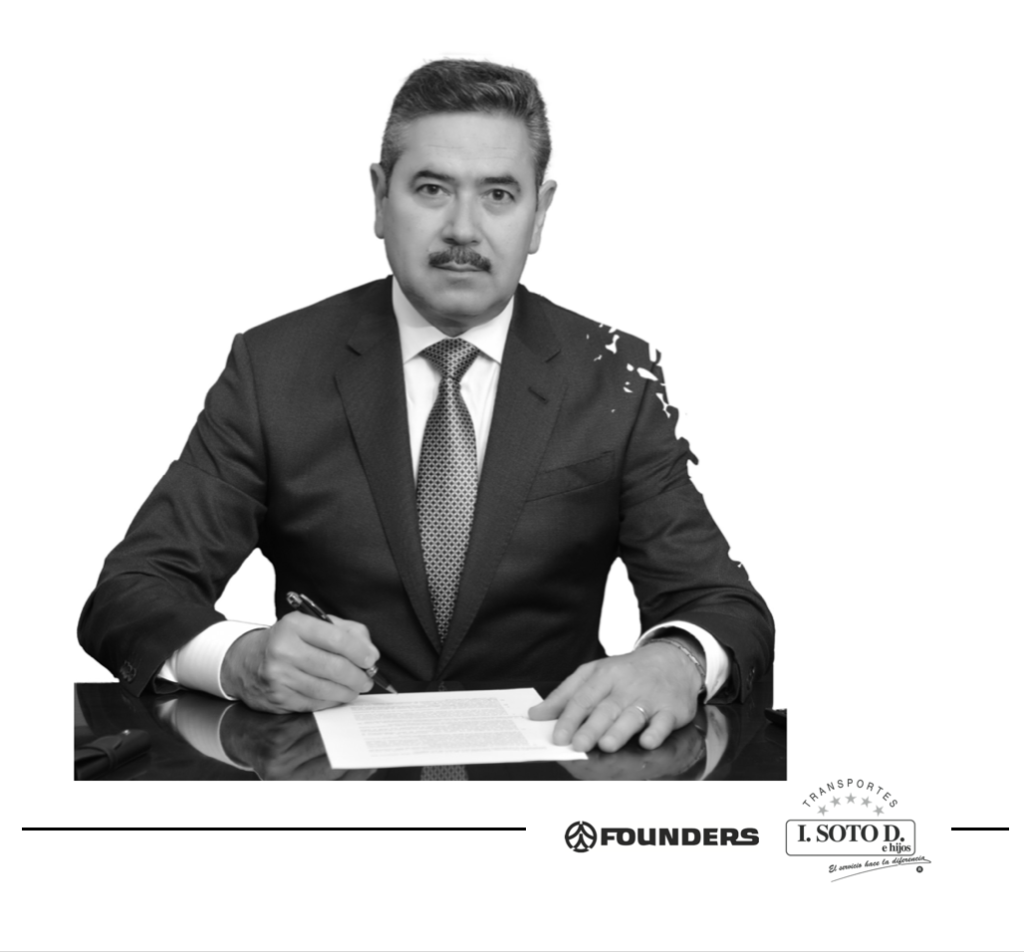By: Omar Soto Sepúlveda
CEO
FOUNDERS ENTERPRISES INC./ TRANSPORTES SOTO E HIJOS
“To be a leader, you must first have the courage to admit your mistakes, choose to learn from them, and have the maturity to correct them.”
In this article, I would like to share how I have learned to overcome hardship and created a company that has a life of its own, which will survive, with or without me, for many years to come. I am, and it is, still a work in progress, but I firmly believe that to achieve this goal, my primary function within the company is to be a transformational leader and promoter of change. I will stress during my article how important it is for a leader to learn how to communicate and motivate our team members to allow them to become “the innovators” and thereby set a culture of a company that evolves independently of its owner.
To give you a bit of background, I think it is important to share with you that this has been a long journey that started with my father buying and restoring a burnt-out truck that my family restored. You might ask why a burnt-out truck. Well, because that was the only truck on the lot we could afford. There were no frills, bells, or whistles but a means to start a trucking business.
We have come a long way since then. Today we have hundreds of trucks and three logistics terminals. Our operations span from the USA well into Mexico. Although we are growing furiously and work in many different sectors, our most precious cargo will always be our drivers.
What it takes
Transformational leadership is all about helping our team members on every single level of the organization realize that they are the leaders of tomorrow. I have seen that this transforms their level of commitment because they are part of what we are doing, not a means to what the organization wants to achieve. This, in turn, generates two things; for one, in a low practical way, a much better economic situation for them and their family, but also an increase in the welfare of their communities far beyond what they might be making in our company.
We all have seen companies transform their business models out of need; when they have encountered challenges, some do it successfully others fail. We have all seen the example of Kodak. Time will tell what ultimately happens to this company that changed late and did not take advantage of its privileged position in the market. I believe in a type of leadership that transforms the organization before it is needed through its team members.
One might call it qualities or abilities that the company’s leader should have to initiate this transformation from within the company and for it to become part of the team-spirit character of the company. I feel the most important are:
Enthusiasm: The noun originates back to Ancient Greece “enthousiasmos” and comes from the combination of three words “en” (in), “theós” (god), and “ousía” (essence), meaning “inspired by god’s essence.” It was originally used in a derogatory sense to describe excessive religious zeal. Today both the religious and derogatory connotations are gone from enthusiasm, but the zeal has survived.
To me, enthusiasm springs up when the person passionately discovers his reason for being. I am fortunate to have seen it truly happen a few times. The result is that it makes the bearer of this “enthusiasm” capable of leaving a legacy that transcends generations.
“Be as enthusiastic about the success of others as you are about your own”
Empowerment: To achieve a transformational company, team members need to be strengthened. One needs to give everyone in the company the confidence, autonomy, tools, and guidance for them to trust that they can make decisions and solve problems by themselves. The transformational leader empowers his colleagues to work for the success of the whole team, not just his/her own. This is an incredible enabler for each individual to reach their full potential, understand their purpose, and give themselves the opportunities to excel. As a team, the organization becomes extraordinary by everyone contributing to a common cause.
It is placing trust in people capable of generating the well-being of others.
Sustainability: One needs to safeguard the current needs of the organization without compromising the needs of future generations within a company. It might seem simple, but I have found that the longest organizations typically think it is reaching the objectives of the next quarter but that the future, the real future, which is the next generation, is just an uncomfortable afterthought. By thinking “real” future, is the only way to achieve a “real” sustainable well-being for all.
“The success of sustainable leadership is not measured by today’s results. But for the ability to generate a chain of conscious and genuine leaders who are constantly committed to building a sustainable future.“
Vision: The leader must be aware of all aspects of the business, such as finances, technology, attitudes, people behaviors, and organizational culture. He is the Captain of the ship, but a transformational ship is a strange ship. It is really everyone around him who make the ship sail; he is just around to remind everyone that they need to work together to be on the best course and adapt faster than the competition.
Organizational transformation, creativity, and innovation are intimately linked and, in turn, are focused on proposing new ideas that can face a future that does not yet exist. This is where vulnerability comes in. Although vulnerable, the transformational organization needs to find the courage to face uncertainty by taking risks that facilitate innovation in a sometimes adverse political, economic, or social environment. Yes, to innovate, it is necessary to be brave to face uncertainty and take the risks that it entails.
“Without vulnerability there is no innovation, because only he who sees the invisible, can achieve the impossible..”
Integrity: The person creating a transformational organization needs to be true to his life’s purpose as well as that of his company. These cannot differ significantly and ideally not differ one bit. When they are aligned, it inspires people and positively impacts both the organization and the community. Only an organization led by a leader who is true to himself will be generous enough, will dedicate his time, can truly empower his colleagues them trust them with authority to achieve extraordinary results.
“Integrity is doing the right thing, even if no one is watching.”
As you can see, the challenges are great, and they are many. It is not easy for all these qualities to exist in a single person, so a leader must surround oneself with an intelligent team with different skills capable of solving adverse situations that help complement each other. In addition, to strengthen your work as a leader, it is crucial to understand the word “Humble.” It is necessary to be honest with yourself and thus be able to identify your areas of opportunity, as well as have the ability to listen to others and trust points of view that become different from your own.
An effective tool that can help put these characteristics into practice is strategic planning in the company of your collaborators. One of the many functions that this tool has is that you will be able to identify your own strengths and areas of opportunity at the individual level as a leader and at the organizational level. That is why humility plays a very important role in accepting comments for the common good of Society.
Within my personal and professional experience, I have been fortunate to live through some difficult stages in my life that have shaped me to become the person I am today. To name a few, I would like to mention the difficult loss of my mother in my adolescence, very early on, having the responsibility of growing the family business, creating the structure it required to become a noteworthy company, suffering my father’s illness and departure, becoming executor of his inheritance, restructuring the company’s shareholding, reengineering the conglomerate of companies we had become, encouraging the culture change of a transformational organization, professionalizing the companies and lately being vigilant of the generational transition I am working on.
Given the experience of all these experiences mentioned above, I would like to recommend the following tips that have been of great support to me and that I consider can also be helpful:
- Reach out to the right people who have the experience to share with you to develop you and your team.
- Get involved in subjects that generate value and are aligned with what you seek.
- Meet people who have businesses that are different from yours and try to figure out how they overcame challenges.
- Create a council within your company and invite your colleagues to participate. When you do this, let there be people from all levels within the organization.
- Constantly learn about topics that help you envision the future as an agent of change.
- Finally, look for consultants and advisors in the areas in which you feel your organization requires support.
One of the biggest challenges I have faced in my career as a leader and as a General Manager of the Group has been the following:
- Delegate: Letting go of the reins and putting them in the hands of “strangers” is a difficult decision. However, with the passing of time, you will realize that there are people more capable than you.
- Gender Transition: In this era where there can be up to four generations working together, empathy and compassion are essential. Learning to work with people’s changing expectations within quickly evolving generational gaps has been challenging for me.
- Transcendence: Without a doubt, the most cherished dream of someone like me is that the company exists for many generations to come. The only answer I can find is to create a culture of continuous autonomous transformation.
As you can see, there are many activities and challenges that someone who aims to create a transformational organization faces, especially in times when uncertainty and change are a constant, but without a doubt, these activities and challenges are part of the development and transcendence. It’s clear that it’s hard work and a long way to go, but to me, it’s worth a try.
For your team to see all this development as a positive impact, it is vital to give them an approach in which they obtain a personal benefit as well as self-realization within the business environment. In this way, each of the members will find his raison d’être and contribute favorably to the common good.
Therefore, if this is the way you choose to go, I would recommend that you design a general plan and a few basic guidelines for what you want to achieve. Try to delegate all the activities you have been performing so far, yes, ALL. Your future focus should not be on the present but on visualizing the future.
I’ll wrap up my article by saying that I am not perfect, but I try to be a good leader. What I do have is a strong will and the firm conviction to lead my company to a place that creates welfare for all my colleagues, their families and for our society. I know that I have an incredible team, that we complement each other, and that thanks to them, our company will be here tomorrow and for many generations to come. For the same reason, my pledge to God is the same as I have for my company: “Serve to help, Learn to teach”… So be it…
“Never Let success come to the head and failure to the head heart.”
Someone once asked me what I would like to be reborn as, and I answered: “A truck driver.”




